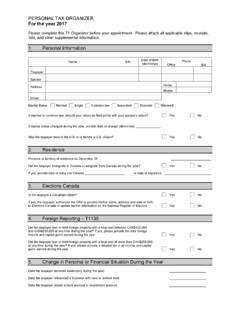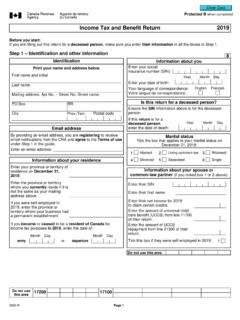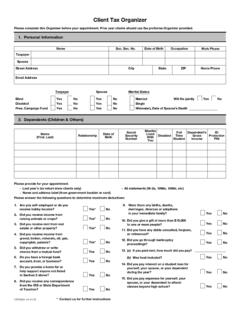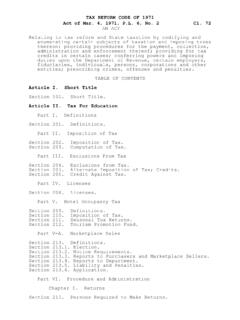Transcription of Taxability of Property Distributions from Trusts
1 Taxability of Property Distributions from Trusts Trusts : The Tax Consequences Depend on the Type of distribution Made By Donita M. Joseph, CPA, MBT Originally published in Spidell s August 2009 Newsletter What are the tax consequences when an estate or trust makes a distribution of Property (as opposed to cash)? Will the trust issue a form K-1 to the beneficiary? If so, how much income will be reported on that K-1? Is the estate or trust required to recognize gain on the distribution ? Can the estate or trust elect to recognize gain if it is not required?
2 What will the tax basis of the Property be in the beneficiary s hands? What holding period will the beneficiary use for the asset received? Dealing with Property Distributions out of Trusts and estates can be quite confusing. It is important to check the rules whenever analyzing them in conjunction with the preparation of the fiduciary income tax return. This article may be used as a handy reference the next time you must sort out the tax ramifications of a beneficiary receiving Property from a trustee or executor. Distributions of Specific Property A specific bequest is not considered a taxable distribution to the beneficiary if it is a distribution of a specific Property or a specific sum of money.
3 These Distributions do not carry out income to the beneficiary and they generate no income distribution deduction to the estate or No gain or loss is recognized on the The beneficiary receiving the distribution has a carryover The fiduciary should notify the beneficiary of the tax basis and holding period of the asset when the distribution is made. Distributions of specific Property must be specifically identified in the will or trust and must be payable in three or fewer installments. Property Substituted for Specific Property What happens if, instead of receiving the personal residence in the example above, the trustee substitutes common stock with a value equal to that of the personal residence on the distribution date?
4 The distribution does not carry out income to the beneficiary and generates no income distribution deduction to the estate or Gain is recognized at the fiduciary level. The distribution is treated as a distribution of cash in an amount equal to the fair market value of the Property , followed by a deemed sale to the beneficiary of the Property for the cash. Loss is not recognized at the fiduciary level. The beneficiary s basis is the carryover basis plus any gain recognized by the fiduciary. EXAMPLE: Under the terms of the ABC trust , Janet is to receive the personal residence held by the trust .
5 The tax basis to the trust is $500,000. The fair market value of the house on date of distribution to Janet is $550,000. Result: No distributable net income (DNI) carries out to Janet if she does not receive any other Distributions ; The trust recognizes no gain on the distribution of the house; and Janet s basis in the house = $500,000. Under IRC 267, a loss is denied on a sale to a related party. This comes into play when a fiduciary funds a bequest with an asset whose basis exceeds its fair market value. Related parties for this purpose would be: The fiduciary of a trust and a fiduciary of another trust with the same grantor; The fiduciary and beneficiary of the same trust ; The fiduciary of a trust and a beneficiary of another trust with the same grantor; or An estate and an estate beneficiary except when the estate funds a pecuniary (fixed-dollar) bequest.
6 Simple Fixed-Dollar Bequests In this instance, the bequest to the beneficiary is a dollar amount ( , $500,000), but instead of receiving cash, the beneficiary receives other Property . The rules differ for pecuniary (fixed-dollar) bequests, based on the number of installments in which the bequest is to be paid. In the case of simple pecuniary bequests funded at fair market value of Property distributed in less than three installments, or where the document is silent regarding installments: The distribution is not taxable income to the beneficiary and generates no income distribution deduction to the estate or trust ;5 Gain or loss is recognized by the fiduciary; and The beneficiary s tax basis = fair market value at distribution .
7 When a simple pecuniary bequest is funded with fair market value of Property distributed in more than three installments, the treatment is different. For example, the beneficiary is to receive $500,000 payable in ten installments of $50,000 each. The trustee distributes other Property to the beneficiary in lieu of cash. The distribution is taxable income to the beneficiary to the extent of the fair market value of the assets;6 Gain or loss is recognized by the fiduciary; and The beneficiary s tax basis = fair market value at distribution .
8 Formula Pecuniary Bequests In some cases, the will or trust will contain language that provides varying degrees of direction as to how to accomplish the Distributions or bequests. Here are some examples, and how to handle them. If the will or trust has language along these lines: I give to my wife, Gertrude, the lowest pecuniary amount .. All assets selected are to be valued at the fair market value as of the date distributed. 7 Gain or loss is recognized by the fiduciary;8 The distribution does not carry out income to the beneficiary and generates no income distribution deduction to the estate or trust ; and The beneficiary s tax basis will be the fair market value at the date of distribution .
9 If the trust or will says: My executor is directed to select and distribute .. sufficient assets .. using for valuation purposes the adjusted income tax basis of each asset selected or My executor must choose the assets .. in such a way that they have an aggregate fair market value fairly representative of the appreciation or depreciation in value of all assets available for distribution as of the date(s) of distribution . 9 Gain or loss not recognized by the fiduciary;10 The distribution does not carry out income to the beneficiary and generates no income distribution deduc-tion to the estate or trust ; and The beneficiary s tax basis will be the carryover basis of the Property in the hands of the fiduciary.
10 Or, the document may say: My executor shall choose and distribute the assets .. by using for valuation purposes the lesser of the asset s adjusted basis for federal income tax purposes or the value of the asset at the date(s) of distribution . 11 Gain is not recognized;12 Loss is recognized; The distribution does not carry out income to the beneficiary and generates no income distribution deduction to the estate or trust ; and The beneficiary s tax basis will be the carryover basis minus any loss recognized by the fiduciary.









